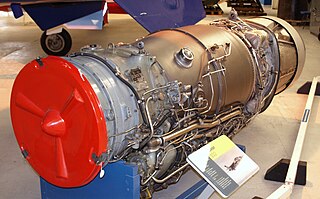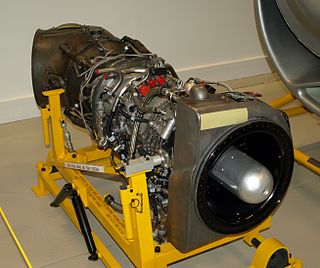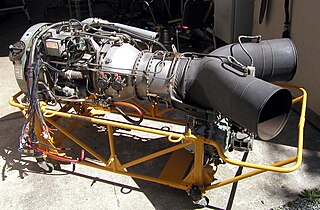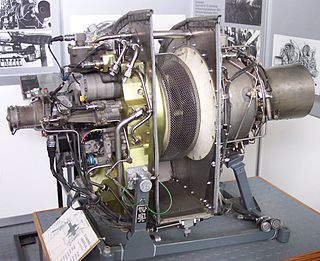
The Rolls-Royce Turbomeca Adour is a two-shaft low bypass turbofan aircraft engine developed by Rolls-Royce Turbomeca Limited, a joint venture between Rolls-Royce (UK) and Turbomeca (France). The engine is named after the Adour, a river in south western France.

Safran Helicopter Engines, previously known as Turbomeca, is a French manufacturer of low- and medium-power gas turbine turboshaft engines for helicopters. The company also produces gas turbine engines for aircraft and missiles, as well as turbines for land, industrial and marine applications.

The Rolls-Royce Turbomeca RTM322 is a turboshaft engine produced by Rolls-Royce Turbomeca Limited, a joint venture between Rolls-Royce plc and Turbomeca. The engine was designed to suit a wide range of military and commercial helicopter designs. The RTM322 can also be employed in maritime and industrial applications.

MTU Aero Engines AG is a German aircraft engine manufacturer. MTU develops, manufactures and provides service support for military and civil aircraft engines. MTU Aero Engines was formerly known as MTU München.

The LHTEC T800 is a turboshaft engine for rotary wing applications. It is produced by the LHTEC, a joint venture between Rolls-Royce and Honeywell. The commercial and export version is the CTS800. The engine was primarily developed for the United States Army's cancelled RAH-66 Comanche armed reconnaissance helicopter, but has found use in other applications.

The MTU Turbomeca Rolls-Royce MTR390 is a turboshaft developed for light helicopter applications by MTU Turbomeca Rolls-Royce (MTR). The engine is designed to power helicopters in the weight range of 5-7 tonnes in both single and twin engine configurations. So far the only application is the Eurocopter Tiger. Test runs of the MTR390 began in 1989 and the first test flight was performed in 1991. The MTR390 received military certification in May 1996 and civil approval in June 1997.
MTU Turbomeca Rolls-Royce GmbH (MTR) is a multinational engine manufacturer established to develop, manufacture, and service the MTR390 turboshaft engine. It is a joint venture between three European aero-engine manufacturers, Germany's MTU Aero Engines, France's Turbomeca and Britain's Rolls-Royce.

Safran Aircraft Engines is a French aerospace engine manufacturer headquartered in Courcouronnes and a subsidiary of Safran. It designs, makes and maintains engines for commercial and military aircraft as well as rocket engines for launch vehicles and satellites.

The Napier Gazelle is a turboshaft helicopter engine that was manufactured by D. Napier & Son in the mid-1950s. In 1961 production was nominally transferred to a joint venture with Rolls-Royce called Napier Aero Engines Limited. But the venture closed two years later.

The Rolls-Royce Gnome is a British turboshaft engine originally developed by the de Havilland Engine Company as a licence-built General Electric T58, an American mid-1950s design. The Gnome came to Rolls-Royce after their takeover of Bristol Siddeley in 1968, Bristol having absorbed de Havilland Engines Limited in 1961.

The Bristol Siddeley Nimbus, later known as the Rolls-Royce Nimbus, was a British turboshaft engine developed under license by Blackburn Aircraft Ltd. from the Turbomeca Turmo in the late 1950s. It was used on the Westland Scout and Westland Wasp helicopters.

The Rolls-Royce Gem is a turboshaft engine developed specifically for the Westland Lynx helicopter in the 1970s. The design started off at de Havilland and was passed to Bristol Siddeley as the BS.360. When Rolls-Royce bought out the latter in 1966, it became the RS.360.

The Turbomeca Astazou is a highly successful series of turboprop and turboshaft engines, first run in 1957. The original version weighed 110 kg (243 lb) and developed 240 kW (320 shp) at 40,000 rpm. It was admitted for aviation service on May 29, 1961, after a 150-hour test run. The main developing engineer was G. Sporer. It was named after two summits of the Pyrenees.

The Turbomeca Arriel is a series of French turboshaft engines that first ran in 1974. Delivering 650 to 1,000 hp, over 12,000 Arriel engines have been produced from 1978 to 2018, logging more than 50 million flight hours for 40 helicopter applications. In June 2018, 1,000 Arriel 2D were in service, powering H125 and H130 single-engine helicopters, having logged one million flight hours since 2011. After endurance tests and fleet data analysis, their TBO increased by 25% to 5,000 hours and mandatory inspection rose to 15 years with no hourly limit, lowering maintenance costs.

The Turbomeca Arrius is one of a family of turboshaft engines for helicopter use, first produced in 1981. As of 2012, some 2,700 units had been sold. Power ranges between 357 kW and 530 kW for different versions. Following Turbomeca tradition, the Arrius was named after a Pyrenean peak, located in the Ossau Valley near Pau.

The Turbomeca Turmo is a family of French turboshaft engines developed for helicopter use. A descendant of the Turbomeca Artouste, later versions delivered up to 1,300 kW (1,700 shp). A turboprop version was developed for use with the Bréguet 941 transport aircraft.

The Turbomeca Makila is a family of French turboshaft engines for helicopter use, first run in 1976 and flown in 1977.

The Westland 30 is a British medium helicopter based on the Westland Lynx military helicopter. Although Westland Helicopters foresaw a market for the type in VIP, passenger and cargo transport, and off-shore support operations, production remained limited, ending in 1987 after 41 aircraft had been built.

The Safran Ardiden is a 1,400–2,000 hp (1,000–1,500 kW) turboshaft designed and produced by Safran Helicopter Engines for 5–8 t (11,000–18,000 lb) single and twin-engine helicopters. Launched in 2003 as a more powerful TM 333, it first ran in 2005 and was introduced in 2007. The Ardiden 1 Shakti powers the Indian HAL Dhruv, Light Combat Helicopter and Light Utility Helicopter while the more powerful Ardiden 3 powers the Avicopter AC352 and Kamov Ka-62.
Turbo-Union Limited is a joint venture between three European aero-engine manufacturers, FiatAvio, MTU Aero Engines and Rolls-Royce.



















